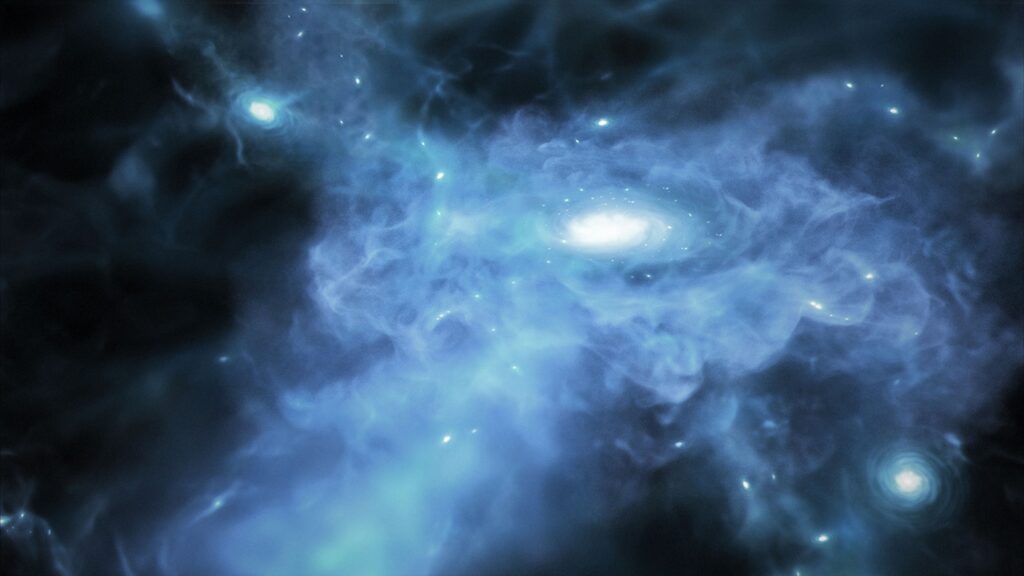One of the main goals of the James Webb Space Telescope (JWST) is to use its powerful infrared optics to discover the first galaxies as they were forming and to study the early universe. Using Webb's data, a team led by Denmark's Cosmic Dawn Center identified three galaxies that appear to have been actively forming just 400 to 600 million years after the Big Bang, marking a period of reionization when the universe was permeated with opaque clouds of neutral hydrogen, slowly heated and ionized by the first stars and galaxies.
This process caused the universe to become transparent about a billion years after the Big Bang, and thus visible to astronomers today. When the team examined the data Webb had acquired, they found that these galaxies were surrounded by unusual amounts of dense gas composed almost entirely of hydrogen and helium, which likely fueled further galaxy growth. These discoveries have already revealed valuable information about the formation of early galaxies, indicating that Webb is exceeding its mission objectives.
The study was led by NASA Hubble Fellow and Assistant Professor of Astrophysics Kaspar E. Heinz and colleagues at the Niels Bohr Institute's Cosmic Dawn Center (DAWN), with participation from ETH Zurich, MIT Kavli Institute for Astrophysics and Space Research, the Space Telescope Science Institute (STScI), the Association of Universities for Research in Astronomy (AURA), the European Space Agency (ESA), NSF's National Optical and Infrared Astronomy Laboratory (NOIRLab), and several universities.
 Diagram showing the process of reionization in the universe divided into four periods. Courtesy of NASA
Diagram showing the process of reionization in the universe divided into four periods. Courtesy of NASA
According to models of galaxy formation, the first galaxies should have formed when neutral, pure gas fell into the first protogalactic halo. But the abundance of neutral atomic hydrogen in galaxies remains unknown due to the difficulty of observing the early universe. “These galaxies are like glowing islands in a sea of neutral, opaque gas,” Heinz explained in a NASA press release. “Without Webb, we would never have been able to observe these very early galaxies, much less learn much about their formation.”
Because the galaxies only appeared as red blobs in the Webb images, the team also leveraged data acquired by Webb's Near Infrared Camera (NIRCam) through the Cosmic Evolution Early Open Science (CEERS) Survey and shared through the Early Open Science (ERS) program. The spectra revealed that the light from these galaxies is absorbed by large amounts of neutral hydrogen gas. The team then matched the Webb data with star formation models, revealing that these galaxies are composed primarily of young stars. Co-author Darach Watson, DAWN Professor, said:
“The gas is very widespread and must cover a fairly large part of the galaxy. This indicates that we are seeing neutral hydrogen gas collecting in the galaxy. That gas will cool and solidify to form new stars. The fact that we are seeing a large gas reservoir also suggests that the galaxy has not had enough time to form most stars yet.”
“The idea of galaxies as isolated ecosystems is becoming a thing of the past,” added Simone Nielsen, DAWN co-author and doctoral student. “At this stage in the history of the universe, galaxies are all intimately connected to an intergalactic medium with primordial gas filaments and structures.”
 A timeline from the Big Bang on the right to the present on the left. In the middle is the reionization period when the early bubbles caused the dawn of the universe. Credit: NASA SVS
A timeline from the Big Bang on the right to the present on the left. In the middle is the reionization period when the early bubbles caused the dawn of the universe. Credit: NASA SVS
These results show what astronomers are now able to do, thanks to next-generation telescopes like Webb. Of course, many open questions remain, not the least of which concerns the distribution of cold gas in these early galaxies. For example, how much gas is there near the center of the galaxy versus in its outskirts? And astronomers are not yet sure whether this gas is pure or already dominated by heavier elements. As Heinz pointed out, “The next step is to build a large statistical sample of galaxies and quantify in detail the spread and prominence of their features.”
Further reading: NASA, Science
like this:
Like Loading…



